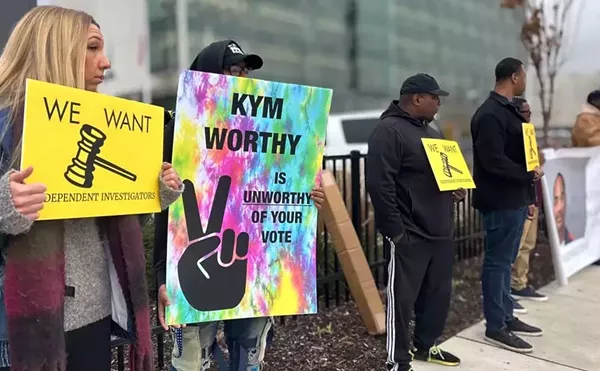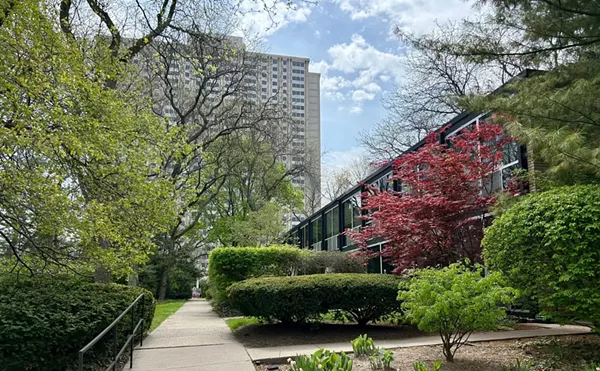
Audio By Carbonatix
[
{
"name": "GPT - Leaderboard - Inline - Content",
"component": "35519556",
"insertPoint": "5th",
"startingPoint": "3",
"requiredCountToDisplay": "3",
"maxInsertions": 100,
"adList": [
{
"adPreset": "LeaderboardInline"
}
]
}
]
The final results of "Count Day" won't be known for at least a week, but regardless of what they show — whether or not the majority of the missing 25,000 Detroit youngsters ultimately returned to Detroit Public Schools in time for the district to get the millions of dollars in state funds it needs to keep treading water — the desperate condition of public education in the city of Detroit is likely to remain in a desperate condition for years to come. It will take a hell of a lot more than ice cream parties and computer giveaways to get this ship back on course, and it will take considerably more than a last-minute school attendance rescue mission to guarantee Detroit youngsters the kind of education they need to survive.
For those with short memories, or who haven't been paying attention to what could arguably be said to be Detroit's most urgent crisis, 25,000 students were missing from Detroit public schools two weeks ago following the controversial teachers strike. School officials had already planned on losing 9,400, which is a huge number all by itself, but when more than twice that number turned up absent the panic alarms began to sound. Not surprisingly, it was the potential loss of $190 million in state funds that triggered the alarm. In a district that is already strapped for cash, a shortfall of that magnitude could cripple it beyond repair — and it's close to that condition already.
Jumping into hyperdrive, the district pulled out all the stops to track down as many of these missing kids as possible, each of whom is worth $7,450 in state funding, and return them to the classroom by last Wednesday, Sept. 27, deadline day, to save the dollars. Predictably, school officials said last week that a preliminary count looks good and that lots and lots of kids returned to school.
One well-placed observer of this mess is John Telford, a teacher at Finney High School who has a lengthy record going back nearly 50 years as a teacher, administrator, coach and activist in a number of Detroit schools as well as in the suburbs. A former track star, the track at Finney is now named for him. He is also the retired deputy superintendent of Rochester Schools, and the former executive director of secondary education for the Plymouth-Canton School District. Telford isn't at all convinced that the numbers from Count Day will even come close to 25,000 once the final tally is done. But even if they do, Detroit schools will still be trapped in the muck of dysfunction and disrepair.
"First of all, it's not gonna happen unless they fudge the figures," Tilford said when asked about DPS' prospects for hitting the magic number. "But even if it does happen, and it won't, the district will still have to lay off at least 6,000 employees."
So where are these kids who failed to show up? According to recent news reports, outlying school districts and charter schools did receive a fairly large number of parents trying to get their children enrolled, and some succeeded. But were 25,000 kids relocated? Not even close.
"They don't have the capacity," Telford said of the suburban schools. As to the missing kids: "They're hanging out at home. Or out with their buddies."
As one of the thousands of teacher foot soldiers who sees every day what is going on in one of the city's most troubled high schools, Telford is adamant that, count or no count, Detroit's kids are getting shafted by a school system that seems incapable of addressing their needs. It's not that there aren't good teachers in the schools, and it's not that some district administrators aren't doing the best they can with what they have to work with to dull the pain, but without radical surgery the patient just might die.
"The school district is broken," he said. "They take care of the kids at Cass, Renaissance and the High School for the Arts, but they neglect the other 110,000, or however many more are left.
"You want to know what I've been doing? Subbing. I've been subbing in English, science, social studies. ... Yesterday I subbed in six classes," he said. That's because there aren't enough teachers and the best way to keep the kids from fighting and causing other trouble is to keep them in a classroom. He was hardly alone trying to plug the dike. This kind of thing happens all the time.
Telford's formal title at Finney is curriculum coordinator-community liaison, but he and many other DPS teachers are well accustomed to going far beyond the job description simply to keep the schools from imploding and to serve the kids as best they can — which isn't always so good.
"We didn't have a librarian in Finney for a year and a half. The pool in Finney hasn't worked for five years. I took the kids over to Grosse Pointe North, and they're looking at this Olympic-sized pool, and here we are with a pool that hasn't been filled for five years. And these kids [at Grosse Pointe North] are public school kids just like the kids in Detroit."
When I asked Telford what he thought needed to be done to get the district back on track, all he could do for several moments was moan.
"Man, I don't know where to start. First we need to get the kids to read. We've got kids in high school who can only read at a third-grade level. What do you do with high school and middle school kids who can't read? There's a lot of prisons being built for them. It's a growth industry."
Then there are the kids who come to school hungry, and the ones without access to transportation and who, in some instances Telford said, walk as much as three miles from home to get to class. Then there are the teachers who need to be paid competitive wages, and who shouldn't be required to buy school supplies with their own money or to spend more of their money feeding hungry students who aren't being fed at home.
"Where do you start?"
Intelligent what?: Normally in this column I don't get too involved in the political arena. I leave that to others. But when I heard that Dick DeVos, Republican candidate for governor, who is buying his way into the hearts and minds of citizens throughout the state as best he can, actually believes in the legitimacy of the so-called "intelligent design" theory and that it should be taught in our public schools, it became hard to sit still. If he manages to regain the lead over Gov. Jennifer Granholm and become Michigan's chief executive, then we have only begun to have problems in this state. Granholm certainly hasn't been Michigan's salvation, and it's fair to say she hasn't completely lived up to her promise, but next to DeVos the woman walks on water. Of course, appearing divine next to DeVos is not exactly a difficult task, but you get the point.
I have nothing against God. I happen to believe in God quite strongly. But that's my belief. My belief in God and whatever his involvement was in the creation of man — whether it was out of a lump of clay or whether God opted for letting evolution take its course — is what I choose to believe and doesn't need to be taught to kids in public school. Intelligent design — regardless of who does or doesn't believe it — doesn't belong in a school system designed to educate intelligent human beings.
Keith A. Owens is a Detroit writer, editor and musician. Send comments to letters@metrotimes.com




